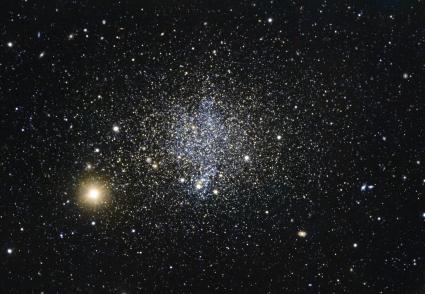The question of how small, dwarf galaxies have sustained the formation of new stars over the course of the Universe has long confounded the world’s astronomers. Now, an international research team has found that dormant small galaxies can slowly accumulate gas over many billions of years. When this gas suddenly collapses under its own weight, new stars are able to arise. The new work is published in Monthly Notices of the Royal Astronomical Society.
There are around two thousand billion galaxies in our Universe and, while our own Milky Way galaxy encompasses between two to four hundred billion stars, small dwarf galaxies contain only tens of thousands to a few billion stars. How stars are formed in these tiny galaxies has long been shrouded in mystery.
Now, a research team from Lund University, Sweden, has established that dwarf galaxies are capable of lying dormant for several billion years before starting to form stars again.
“It is estimated that these dwarf galaxies stopped forming stars around 12 billion years ago. Our study shows that this can be a temporary hiatus,” says Martin Rey, an astrophysicist at Lund University and the leader of the study.
Through high-resolution computer simulations, the researchers demonstrate that star formation in dwarf galaxies ends as a result of heating and ionisation from the strong light of newborn stars across the Universe. Explosions of so-called white dwarfs – small faint stars made of the core that remains when normal-sized stars die – further contribute in preventing the star formation process in dwarf galaxies.
“Our simulations show that dwarf galaxies are able to accumulate fuel in the form of gas, which eventually condenses and gives birth to stars. This explains the observed star formation in existing faint dwarf galaxies, which has long puzzled astronomers,” states Rey.
The computer simulations used by the researchers in the study are extremely time-intensive: each simulation takes as long as two months and requires the equivalent of 40 laptop computers operating around the clock. The work is continuing with the development of methods to better explain the processes behind star formation in our Universe’s smallest galaxies.
“By deepening our understanding of this subject, we gain new insights into the modelling of astrophysical processes such as star explosions, as well as the heating and cooling of cosmic gas. In addition, further work is underway to predict how many such star-forming dwarfs exist in our Universe, and could be discovered by astronomical telescopes,” concludes Rey.
Media contacts
Johan Joelsson
Lund University
Tel: +46 46 222 71 86
johan.joelsson@science.lu.se
Morgan Hollis
Royal Astronomical Society
Mob: +44 (0)7802 877 700
press@ras.ac.uk
Science contacts
Martin Rey
Department of Astronomy and Theoretical Physics
Lund University
Tel: +46 46 222 15 77 (Sweden)
Tel: +44 7706 922 707 (UK)
martin.rey@astro.lu.se
Images and captions

Further information
The new work appears in, “EDGE: From quiescent to gas-rich to star-forming low-mass dwarf galaxies”, M.P. Rey, A. Pontzen, et al., Monthly Notices of the Royal Astronomical Society (2020), in press (DOI: 10.1093/mnras/staa1640).
A copy of the paper is available from: https://doi.org/10.1093/mnras/staa1640
In addition to Lund University, the following HEIs participated in the work: University College London, University of Surrey, and Centre de Recherche Astrophysique de Lyon (CRAL).
Notes for editors
The Royal Astronomical Society (RAS), founded in 1820, encourages and promotes the study of astronomy, solar-system science, geophysics and closely related branches of science. The RAS organises scientific meetings, publishes international research and review journals, recognises outstanding achievements by the award of medals and prizes, maintains an extensive library, supports education through grants and outreach activities and represents UK astronomy nationally and internationally. Its more than 4,400 members (Fellows), a third based overseas, include scientific researchers in universities, observatories and laboratories as well as historians of astronomy and others.
The RAS accepts papers for its journals based on the principle of peer review, in which fellow experts on the editorial boards accept the paper as worth considering. The Society issues press releases based on a similar principle, but the organisations and scientists concerned have overall responsibility for their content.
In 2020 the RAS is 200 years old. The Society is celebrating its bicentennial anniversary with a series of events around the UK, including public lectures, exhibitions, an organ recital, a pop-up planetarium, and the culmination of the RAS 200: Sky & Earth project.
Follow the RAS on Twitter, Facebook, Instagram and YouTube
Download the RAS Podcast from Audioboom


